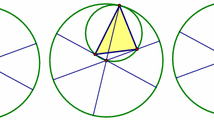Abstract
We study the problem of shortest paths for a line segment in the plane. As a measure of the distance traversed by a path, we take the average curve length of the orbits of prescribed points on the line segment. This problem is nontrivial even in free space (i.e., in the absence of obstacles). We characterize all shortest paths of the line segment moving in free space under the measured 2, the average orbit length of the two endpoints.
The problem ofd 2 optimal motion has been solved by Gurevich and also by Dubovitskij, who calls it Ulam's problem. Unlike previous solutions, our basic tool is Cauchy's surface-area formula. This new approach is relatively elementary, and yields new insights.
Similar content being viewed by others
References
T. Asano, T. Asano, L. Guibas, J. Hershberger, and H. Imai. Visibility-polygon search and Euclidean shortest paths.Proceedings of the 26th IEEE Symposium on Foundations of Computer Science, 1985, pp. 155–164.
A. S. Besicovitch. On Kakeya's problem and a similar one.Mathematische Zeitschrift 27 (1928), 312–320.
C. Blatter, Über Kurven konstanter Breite.Elemente der Mathematik 36 (1981), 105–115.
V. A. Dubovitskij,Zadacha Ulama ob optimal 'nom sovmeshchenii otrezkov. USSR Academy of Sciences, Chernogolovka, Moscow, 1981 (in Russian). English translation:The Ulam Problem of Optimal Motion of Line Segments. Optimization Software, New York, 1985.
H. G. Eggleston.Convexity. Cambridge University Press, Cambridge, 1958.
M. Goldberg. The minimum path and the minimum motion of a moved line segment.Mathematics Magazine 46 (1973), 31–34.
A. B. Gurevich. The “most economical” displacement of a segment.Differentsial'nye Uravneniya 11 (12) (1975), 2134–2143 (in Russian). English translation:Differential Equations 11 (1976), 1583–1589.
D. Hilbert. Über das Dirichlet'sche Princip.Jahresbericht der Deutschen Mathematiker-Vereinigung 8 (1900), 184–188.
J. O'Rourke. Finding a Shortest Ladder Path: A Special Case. IMA Preprint Series No. 353, Institute for Mathematics and Its Applications, University of Minnesota, 1987.
C. H. Papadimitriou and E. B. Silverberg.Optimal piecewise linear motion of an object among obstacles. Algorithmica 2 (1987), 523–539.
W. Rinow.Die innere Geometrie der metrischen Räume. Grundlehren der Mathematischen Wissenschaften in Einzeldarstellungen, Vol. 105. Springer-Verlag, Berlin, 1961.
J. T. Schwartz and M. Sharir. On the piano movers' problem: I. The case of a two-dimensional rigid polygonal body moving amidst polygonal barriers.Communications on Pure and Applied Mathematics 36 (1983), 345–398.
M. Sharir. A note on the Papadimitriou-Silverberg Algorithm for Planning Optimal Piecewise-Linear Motion of a Ladder. Robotics Report No. 188, New York University, 1989.
S. M. Ulam.Problems of Modern Mathematics. Science Editions, New York, 1964. Originally published asA Collection of Mathematical Problems. Interscience, New York, 1960.
I. M. Yaglom and V. G. Boltyanskii.Convex Figures. Holt, Rinehart, and Winston, New York, 1961.
C. K. Yap. Algorithmic Motion Planning. In J. T. Schwartz and C. K. Yap, editors,Advances in Robotics, Vol. 1. Lawrence Erlbaum, Hillsdale, NJ, 1987, pp. 95–143.
Author information
Authors and Affiliations
Additional information
Communicated by Bruce Randall Donald.
This work was partially supported by the ESPRIT II Basic Research Actions Program of the EC under Contract No. 3075 (project ALCOM) and by the Deutsche Forschungsgemeinschaft Grant Ot 64/5-3. Chee Yap acknowledges support from the Deutsche Forschungsgemeinschaft, and partial support from NSF Grants DCR-8401898 and DCR-8401633.
Rights and permissions
About this article
Cite this article
Icking, C., Rote, G., Welzl, E. et al. Shortest paths for line segments. Algorithmica 10, 182–200 (1993). https://doi.org/10.1007/BF01891839
Issue Date:
DOI: https://doi.org/10.1007/BF01891839




